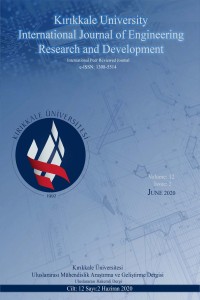Öz
Endüstriyel atıkların depolanması ve bertaraf edilmesi çevresel etki açısından en önemli problemlerden birisidir. Bu atıkların yeniden kullanılması hem çevrenin korunması açısından hem de alternatif hammadde potansiyellerinden dolayı diğer sanayi dallarının ilgisini çekmektedir. Özellikle de seramik sektöründe giderek artan hammadde maliyetleri ve azalan hammadde kaynakları bu atıkların değerlendirilmesinin önemini artırmaktadır. Bu çalışmada, Konya Seydişehir Alüminyum tesislerinin atığı olan kırmızı çamur alternatif bir hammadde kaynağı olarak kullanılmıştır. Yapılan çalışmada seramik duvar karosu reçetelerinde maksimum % 30 oranında kaolin yerine kırmızı çamur ve kalsit yerinede mermer tozu kullanılmıştır. Numuneler 1130 ° C de 60 dakika süre ile laboratuar koşullarında pişirilmiştir. Numunelerin pişme küçülmesi, su emme ve eğme dayanımları gibi teknolojik özelliklerinin yanı sıra sinterleme ve mikroyapı analizleri de araştırılmıştır. Yapılan testler sonucunda kırmızı çamur ilaveli bünyelerin pişme ve ham mukavemet değerleri artmıştır. Ayrıca herhangi bir pigment ilavesi olmadan sadece kırmızı çamur ilavesi ile kırmızı renkli bünyeler elde edilmiştir.
Anahtar Kelimeler
Teşekkür
Yazarlar desteklerinden dolayı Seramik Araştırma Merkezine teşekkürlerini sunar
Kaynakça
- Aydin T., Tarhan M., Tarhan B., (2019). Addition of cement kiln dust in ceramic wall tile bodies, Journal of Thermal Analysis and Calorimetry 136:527–533
- Aydin T., Paksoy, C. , (2019). The effect of cement raw mix waste dust on porcelain tile properties, Journal of the Australian Ceramic Society, 55:37–45
- Aydin T., Kara A., (2016). Effects of Alumina on Porcelain Insulators, Journal of The Australian Ceramic Society, 52[1], 83 – 88
- Kaya E, (2010). Seydişehir kırmızı çamur atığının seramik sanatında değerlendirilmesinin araştırılması, Yüksek Lisans Tezi, Sosyal Bilimler Enst. , Konya Selçuk Üniversitesi
- Ozturk ZB, Eren E., (2007), Preparation of ceramic wall tiling derived from blast furnace slag. Ceram Int., 41(9):12020–6, 2015
- Pontikes Y., Nikolopoulos P, Angelopoulos G.N., Thermal behaviour of clay mixtures with bauxite residue for the production of heavy-clay ceramics, Journal of the European Ceramic Society, 27, 1645–1649
- Selli NT. (2015). Development of anorthite based white porcelain stoneware tile compositions. Ceram Int., 41:7790–5, 2015
- Taoyong L., Jiashuo Z., Jiaqi W., Jianlei L., Cui L., Tanxiang N., Zhiwei L., Xin Z., Qifeng Y., Anxian L., (2019). The utilization of electrical insulators waste and red mud for fabrication of partially vitrified ceramic materials with high porosity and high strength. Journal of Cleaner Production 223 790-800
- Tarhan M., Tarhan B., Aydin T., (2016). The effects of fine fire clay sanitary ware wastes on ceramic wall tiles, Ceramics International, 42, 17110–17115
- Tarhan B., Tarhan M., Aydin T., (2017). Reusing sanitaryware waste products in glazed porcelain tile production, Ceramics International, 43, 3107-31112
- Tarhan M., (2019). Whiteness improvement of porcelain tiles incorporated with anorthite and diopside phases, Journal of Thermal Analysis and Calorimetry, 138, 929–936
Öz
Kaynakça
- Aydin T., Tarhan M., Tarhan B., (2019). Addition of cement kiln dust in ceramic wall tile bodies, Journal of Thermal Analysis and Calorimetry 136:527–533
- Aydin T., Paksoy, C. , (2019). The effect of cement raw mix waste dust on porcelain tile properties, Journal of the Australian Ceramic Society, 55:37–45
- Aydin T., Kara A., (2016). Effects of Alumina on Porcelain Insulators, Journal of The Australian Ceramic Society, 52[1], 83 – 88
- Kaya E, (2010). Seydişehir kırmızı çamur atığının seramik sanatında değerlendirilmesinin araştırılması, Yüksek Lisans Tezi, Sosyal Bilimler Enst. , Konya Selçuk Üniversitesi
- Ozturk ZB, Eren E., (2007), Preparation of ceramic wall tiling derived from blast furnace slag. Ceram Int., 41(9):12020–6, 2015
- Pontikes Y., Nikolopoulos P, Angelopoulos G.N., Thermal behaviour of clay mixtures with bauxite residue for the production of heavy-clay ceramics, Journal of the European Ceramic Society, 27, 1645–1649
- Selli NT. (2015). Development of anorthite based white porcelain stoneware tile compositions. Ceram Int., 41:7790–5, 2015
- Taoyong L., Jiashuo Z., Jiaqi W., Jianlei L., Cui L., Tanxiang N., Zhiwei L., Xin Z., Qifeng Y., Anxian L., (2019). The utilization of electrical insulators waste and red mud for fabrication of partially vitrified ceramic materials with high porosity and high strength. Journal of Cleaner Production 223 790-800
- Tarhan M., Tarhan B., Aydin T., (2016). The effects of fine fire clay sanitary ware wastes on ceramic wall tiles, Ceramics International, 42, 17110–17115
- Tarhan B., Tarhan M., Aydin T., (2017). Reusing sanitaryware waste products in glazed porcelain tile production, Ceramics International, 43, 3107-31112
- Tarhan M., (2019). Whiteness improvement of porcelain tiles incorporated with anorthite and diopside phases, Journal of Thermal Analysis and Calorimetry, 138, 929–936
Ayrıntılar
| Birincil Dil | Türkçe |
|---|---|
| Konular | Malzeme Mühendisliği (Diğer) |
| Bölüm | Makaleler |
| Yazarlar | |
| Yayımlanma Tarihi | 30 Haziran 2020 |
| Gönderilme Tarihi | 23 Nisan 2020 |
| Yayımlandığı Sayı | Yıl 2020 Cilt: 12 Sayı: 2 |


